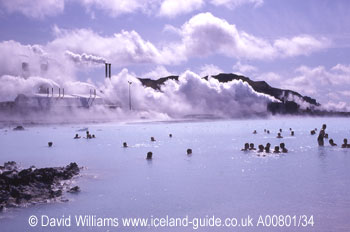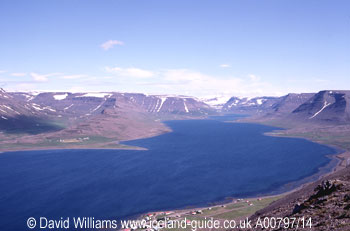 |
| The
Blue Lagoon is one of the coutry`s best-known tourist attractions. |
 |
| This
is the fjord of Dýrafjörður in the North-west Fjords.
In the foreground is the settlement of Thingeyri. |
The most
popular time to visit Iceland is in July and August, when the hours of
daylight are fairly long, the weather generally pleasant and the interior
tracks should be open to vehicles. However, June will be even lighter
(and thus there are more opportunities to see the midnight sun) and the
weather probably drier.
Iceland is now becoming a year-round holiday destination, though winter
travel in some parts of the country will be curtailed because of the weather.
Reykjavík is a colourful city to visit any time of the year
and trips into the countryside (including Thingvellir and Geysir)
are very popular. If the weather is inclement, visitors will find the
capital`s museums, galleries, and other indoor activities of great interest.
Winter visits have a special appeal. During the winter, skiing is available
near the capital, the main slopes being on the Bláfjöll
mountains. For the really adventurous, there are trips in specially-adapted
four-wheel drive vehicles which take visitors over the snow-clad countryside
to huts in the interior. One such destination is Landmannalaugar
where there is an outdoor pool filled by the hot water that runs out from
below a lavafield. This pool is gloriously warm even though snow is lying
all around. Other winter activities that are available include cross-country
skiing, skiddoo driving and perhaps even the opportunity to go fishing
through holes in a lake`s icebound surface! One added attraction of being
in Iceland during the winter is the possible sighting of the Aurora Borealis.
Perhaps the country`s most bizarre year-round and all-weather attraction
is the "Blue Lagoon", an outdoor pool of warm blue water
only 40km from Reykjavík. Believe it or not, the water is the run-off
from the local geothermal power station! Studies have shown the pool`s
water to be beneficial to sufferers of skin ailments such as psoriasis.
Iceland is linked to mainland Europe by air and by sea. Icelandair flies
to Iceland`s international airport at Keflavík, which is
only 48km from Reykjavík. The port of Seyðisfjörður,
which is in the Eastern Fjords, is served by a ferry based in the Faroe
Islands and this connects a number of European ports including Hanstholm
in Denmark. In addition, a new ferry service operated by the Icelandic
shipping line Eimskip links Rotterdam and Reykjavík.
Most of the country`s main attractions are on or near the ring road which
encircles the country and following this route forms the basis for most
visitors` journeys. When time isn`t at a premium, there`s lots to see
in the more remote areas like the North-west Fjords, a huge peninsula
that juts out into the Denmark Strait in the direction of Greenland.
Many visitors take their own vehicles in order that they can travel where
they choose; however, one drawback is that the return ferry journey takes
a few days as there is an enforced stop-over in the Faroes. Fly/drive
holidays are popular but these are best booked well in advance as the
shortness of the tourist season means that hire cars are in great demand.
Bus tours, starting from Reykjavík, are very useful as they allow
visitors to concentrate on enjoying themselves rather than on organising
their stay. Public transport (planes and buses, but no trains) connect
all the main settlements, but if you really want to travel as Icelanders
have done for centuries, then why not go on a pony trip? A number of farms
offer tours of various lengths and some even cross the interior. But watch
out for Hekla!
Back
to the list of articles about this country
|

